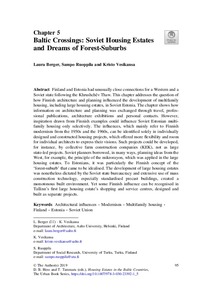Baltic Crossings: Soviet Housing Estates and Dreams of Forest-Suburbs
Berger Laura; Ruoppila Sampo; Vesikansa Kristo
https://urn.fi/URN:NBN:fi-fe2021042821602
Tiivistelmä
Finland and Estonia had unusually close connections for a Western and a Soviet state following the Khrushchëv Thaw. This chapter addresses the question of how Finnish architecture and planning influenced the development of multifamily housing, including large housing estates, in Soviet Estonia. The chapter shows how information on architecture and planning was exchanged through travel, professional publications, architecture exhibitions and personal contacts. However, inspiration drawn from Finnish examples could influence Soviet Estonian multifamily housing only selectively. The influences, which mainly refer to Finnish modernism from the 1950s and the 1960s, can be identified solely in individually designed and constructed housing projects, which offered more flexibility and room for individual architects to express their visions. Such projects could be developed, for instance, by collective farm construction companies (KEK), not as large state-led projects. Soviet planners borrowed, in many ways, planning ideas from the West, for example, the principle of the mikrorayon, which was applied in the large housing estates. To Estonians, it was particularly the Finnish concept of the ‘forest-suburb’ that came to be idealised. The development of large housing estates was nonetheless dictated by the Soviet state bureaucracy and extensive use of mass construction technology, especially standardised precast buildings, created a monotonous built environment. Yet some Finnish influence can be recognised in Tallinn’s first large housing estate’s shopping and service centres, designed and built as separate projects.
Kokoelmat
- Rinnakkaistallenteet [19207]
